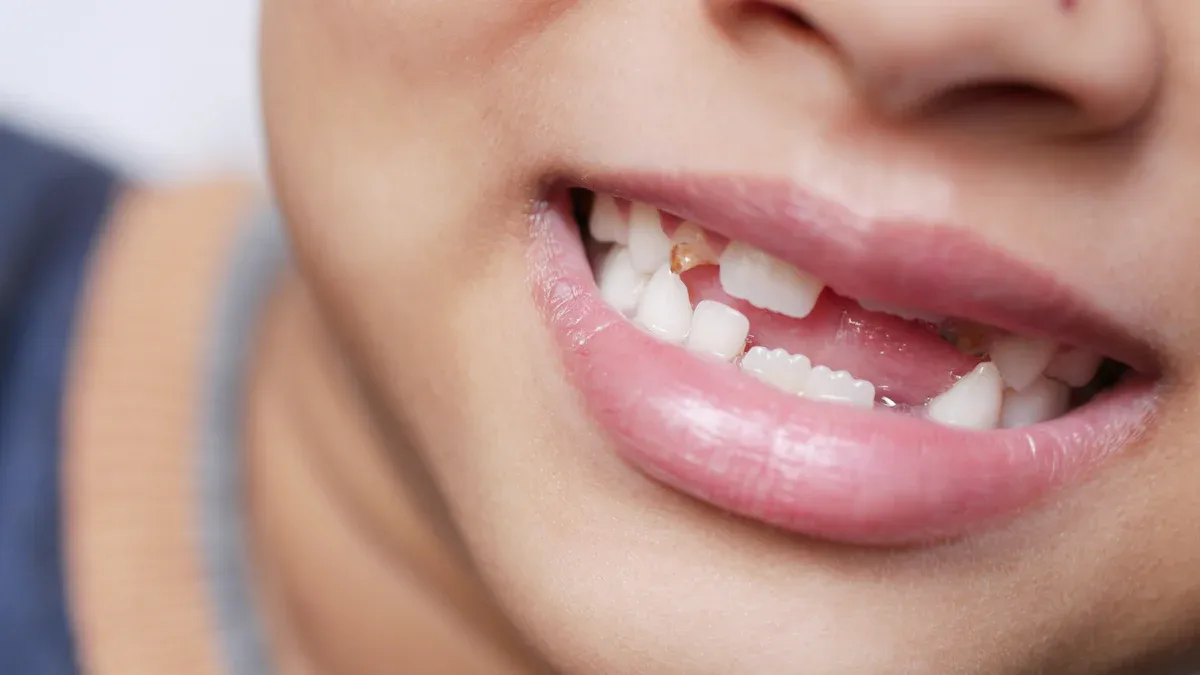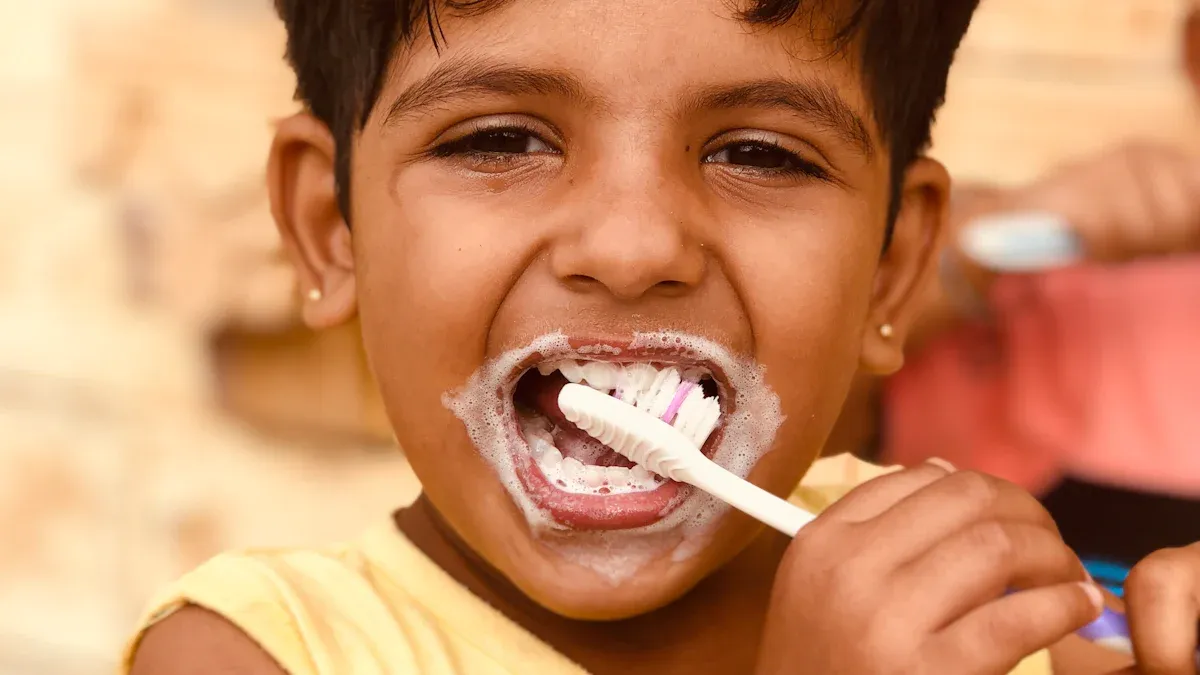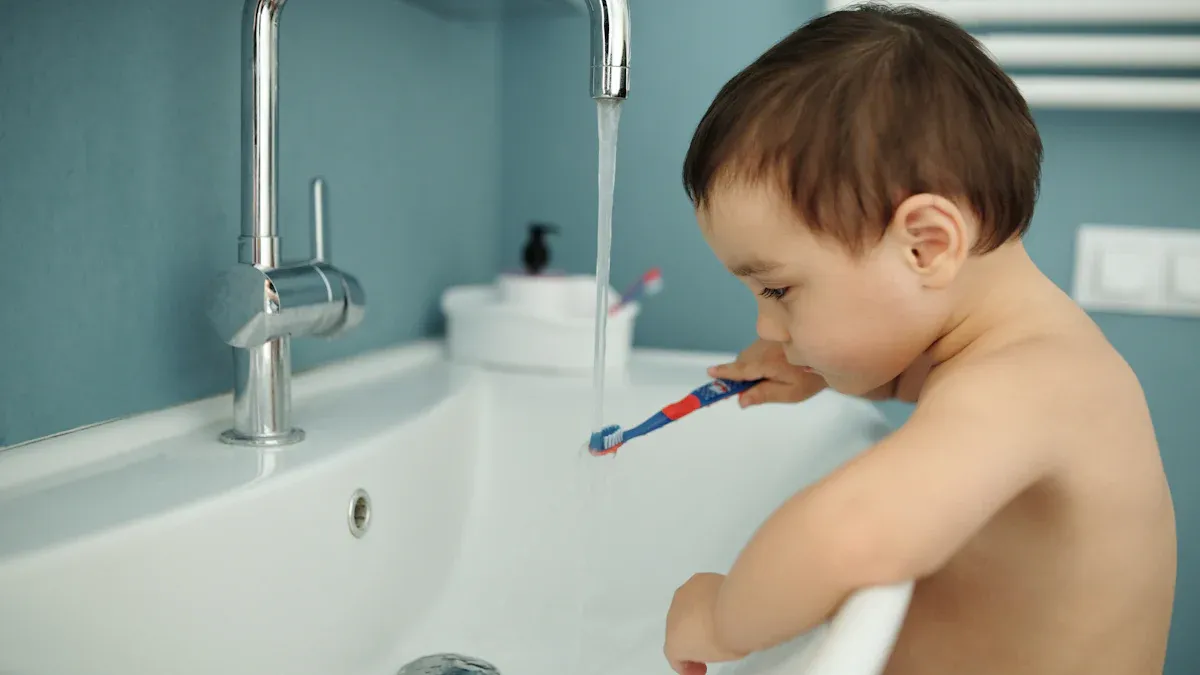Milk Teeth to Permanent Teeth: Your Child's Dental Milestones
Dr. Gianina Camille Gamboa-Garcia is a board-certified pediatric dentist based in Metro Manila.

As a Filipino parent, you play a vital role in shaping your child's dental health. Did you know that 82% of Filipino children suffer from dental caries? This alarming statistic highlights why understanding childhood dental milestones is so important. Poor oral health doesn’t just affect teeth—it can lead to infections, lower Body Mass Index (BMI), and even impact your child’s growth and learning.
Your guidance during the transition from milk teeth to permanent teeth can make all the difference. By staying informed and proactive, you can help your child develop strong, healthy teeth and a confident smile. This guide will empower you to navigate each stage with ease.
Key Takeaways
Learn when milk teeth and permanent teeth grow to help your child’s dental care.
Teach daily brushing and flossing to stop cavities and keep teeth strong.
Make losing a first tooth fun to get your child excited about oral care.
Add healthy foods with calcium and vitamin D to make teeth stronger.
Visit the dentist often to find problems early and keep teeth healthy.
Timeline of Milk Teeth and Permanent Teeth

Milk Teeth Eruption
When to expect the first milk tooth.
You can expect your baby's first tooth to appear around 6 months of age. This is an exciting milestone! Usually, the lower central incisors are the first to erupt. However, every child is different, so don’t worry if it happens a little earlier or later.
Complete set of baby teeth and their order of appearance.
By the time your child is about 2 to 3 years old, they will have a full set of 20 baby teeth, also known as primary teeth. These teeth erupt in a specific order:
Type of Tooth | Typical Age Tooth Erupts | Use of Tooth |
|---|---|---|
Lower central incisor | 6–10 months | Helps bite into food |
Upper central incisor | 8–12 months | Helps bite into food |
Lower lateral incisor | 10–16 months | Assists in cutting food |
Upper lateral incisor | 9–13 months | Assists in cutting food |
First molars (upper) | 13–19 months | Chews and grinds food |
First molars (lower) | 14–18 months | Chews and grinds food |
Canines (upper) | 16–22 months | Tears food |
Canines (lower) | 17–23 months | Tears food |
Second molars (lower) | 23–31 months | Chews and grinds food |
Second molars (upper) | 25–33 months | Chews and grinds food |
Shedding of Milk Teeth
Typical age range for losing milk teeth.
Your child will start losing their milk teeth around age 6. This process continues until about age 12 or 13, when most children have lost all their baby teeth.
Type of Tooth | Typical Age Tooth Sheds |
|---|---|
Lower central incisor | 6–7 years |
Upper central incisor | 6–7 years |
Lower lateral incisor | 7–8 years |
Upper lateral incisor | 7–8 years |
First molars (upper) | 9–11 years |
First molars (lower) | 9–11 years |
Canines (lower) | 9–12 years |
Canines (upper) | 10–12 years |
Second molars (lower) | 10–12 years |
Second molars (upper) | 10–12 years |
How to identify when a child is ready to lose a tooth.
You’ll notice a loose tooth when it’s time for one to fall out. Your child might wiggle it with their tongue or fingers. Encourage them to let it fall out naturally to avoid pain or bleeding. If the tooth doesn’t come out on its own, consult a dentist.
Permanent Teeth Eruption
Timeline for permanent teeth development.
Permanent teeth begin developing at birth, but they don’t erupt until later. By age 6, the first permanent molars usually appear. By age 13, most children have 28 permanent teeth. Wisdom teeth, if they emerge, typically appear between ages 17 and 21.
Common sequence of permanent teeth eruption.
Permanent teeth follow a predictable pattern:
Type of Tooth | Age Range (Years) |
|---|---|
First molars | 6–7 |
Central incisors | 6–8 |
Lateral incisors | 7–8 |
Canine teeth | 9–13 |
Premolars | 9–13 |
Second molars | 11–13 |
Third molars (wisdom) | 17–21 (if at all) |
By understanding these timelines, you can better support your child’s dental health during this important transition.
Caring for Teeth During the Transition

Oral Care for Milk Teeth
Cleaning milk teeth and preventing cavities.
Taking care of your child’s milk teeth is essential for their overall dental health. Start by cleaning their gums even before the first tooth appears. Use a soft, damp cloth to gently wipe their gums after feeding. Once the teeth erupt, switch to a small, soft-bristled toothbrush and a rice-grain-sized amount of fluoride toothpaste. Make brushing a fun activity by singing songs or using a timer.
To prevent cavities, avoid sugary snacks and drinks. Instead, offer healthier options like fruits and vegetables. Studies show that parental involvement plays a huge role in preventing cavities. By supervising daily brushing and teaching proper techniques, you can help your child maintain healthy teeth.
Evidence Type | Description |
|---|---|
Early Childhood Caries Prevention | Educational programs can change feeding practices and reduce cavity risks. |
Parental Involvement | Boosts confidence in performing oral health behaviors effectively. |
Managing teething pain effectively.
Teething can be uncomfortable, but there are ways to ease your child’s pain. Offer a chilled (not frozen) teething ring or a clean, damp washcloth for them to chew on. Gently massage their gums with your finger to provide relief. If the discomfort persists, consult your dentist for safe pain relief options.
Transition from Baby Teeth to Permanent Teeth
Establishing proper brushing and flossing habits.
As your child transitions from baby teeth to permanent teeth, brushing becomes even more important. Teach them to brush twice a day for two minutes using fluoride toothpaste. Show them how to angle the toothbrush to clean all surfaces of their teeth. Once their teeth start touching, introduce flossing to remove food particles between teeth.
Foods and nutrients for healthy teeth.
A balanced diet supports the development of strong permanent teeth. Include foods rich in calcium, like milk and cheese, to strengthen enamel. Vitamin D from sunlight or fortified foods helps the body absorb calcium. Crunchy fruits and vegetables, like apples and carrots, naturally clean teeth and stimulate gums. Avoid sugary snacks, as they can lead to cavities.
Oral Care for Permanent Teeth
Importance of fluoride in preventing cavities.
Fluoride is a powerful tool for preventing cavities in children’s teeth. It strengthens enamel and makes teeth more resistant to decay. Use fluoride toothpaste and encourage your child to drink fluoridated water. If your dentist recommends it, consider fluoride treatments during regular checkups.
Encouraging regular dental checkups.
Regular visits to the dentist are crucial during this transition. These checkups help identify potential issues early, such as misalignment or cavities. Your dentist can also provide professional cleanings and guidance on maintaining oral health. Make these visits a positive experience by celebrating milestones like a cavity-free checkup.
Tip: Start dental visits early to build a positive relationship between your child and the dentist. This helps reduce anxiety and ensures consistent care.
Common Dental Issues and Solutions
Cavities and Tooth Decay
Causes and prevention of cavities in children.
Cavities are one of the most common dental problems in children. They occur when bacteria, like Streptococcus mutans, break down sugars in food, producing acids that damage the enamel. Sugary snacks, poor oral hygiene, and a lack of fluoride can increase the risk of cavities.
To prevent cavities, encourage your child to brush their teeth twice daily with fluoride toothpaste. Limit sugary foods and drinks, and offer healthier alternatives like fruits and vegetables. Regular dental checkups are also essential for early detection and prevention.
Characteristic | Percent with caries in primary teeth (2011–2016) |
|---|---|
Overall | |
Male | 55.4 |
Female | 48.1 |
Mexican American | 72.8 |
Tip: Children from low-income households are more likely to have untreated cavities. Prioritize preventive care to avoid complications.
Treatment options for tooth decay.
If your child develops cavities, don’t worry—there are effective treatments available. Dentists may recommend fluoride treatments to strengthen enamel or sealants to protect teeth from further decay. For more severe cases, fillings or crowns might be necessary. In some instances, advanced therapies like antimicrobial peptides or probiotics can help manage decay.
Misalignment and Orthodontic Concerns
Recognizing signs of misalignment.
Misaligned teeth can affect your child’s bite and overall oral health. Watch for signs like crowded teeth, difficulty chewing, or mouth breathing. Early detection can make treatment easier and more effective.
When to consult an orthodontist.
The American Association of Orthodontists recommends an initial evaluation by age 7. This allows orthodontists to identify potential issues early. Most children begin orthodontic treatments, like braces, between ages 8 and 14.
Recommendation | Age |
|---|---|
Initial evaluation by an orthodontist | 7 |
Ideal age for braces and orthodontic treatments | 8–14 |
Early intervention can prevent more complex problems later. Don’t hesitate to schedule a consultation if you notice any concerns.
Teething Pain and Discomfort
Remedies for teething pain.
Teething can be uncomfortable for your little one. You can ease their pain by gently rubbing their gums with a clean finger or offering a firm rubber teething ring. Avoid frozen teething rings, as they can damage the gums.
When to seek professional help.
If your child experiences severe discomfort, fever, or swollen gums, consult a dentist. Avoid using benzocaine or lidocaine, as the FDA warns against their risks. A dentist can recommend safe and effective solutions tailored to your child’s needs.
Note: Always supervise your child when using teething rings to prevent choking hazards.
Filipino Culture and Dental Care
Traditional Practices and Beliefs
Common Filipino customs for teething and tooth loss.
In the Philippines, many families follow traditional customs when it comes to teething and losing the first tooth. For teething, elders often recommend rubbing a piece of guava leaf on the gums to soothe discomfort. Some parents also use a chilled spoon or a damp cloth to help their toddler manage teething pain.
When it comes to losing the first set of teeth, the "tooth fairy" isn’t the only tradition. Many Filipino families practice the "mouse ritual." After a child loses a tooth, they throw it onto the roof while saying, "Mouse, mouse, take my tooth and give me a better one!" This custom reflects the belief that a mouse’s strong teeth will bless the child with healthy permanent teeth.
Balancing cultural practices with modern dental care.
While these traditions are meaningful, it’s important to balance them with modern dental care. For example, you can still follow the mouse ritual but also teach your child about the importance of brushing and flossing. Use a teeth eruption chart to track their progress and ensure their oral health stays on track. If you’re unsure about a practice, consult your dentist for advice. Combining cultural values with a parent's guide to healthy oral care habits ensures the best of both worlds.
Promoting Positive Dental Habits
Using Filipino values to teach oral hygiene.
Filipino culture emphasizes family and respect, which you can use to teach healthy oral habits. Show your child how brushing their teeth helps them stay healthy for their loved ones. Make it a family activity by brushing together every morning and night. This not only builds routine but also strengthens family bonds.
Celebrating dental milestones like losing the first tooth.
Losing the first tooth is a big deal! Celebrate it to make dental care exciting for your child. You could throw a small "tooth party" or give them a special reward for taking care of their teeth. These celebrations encourage them to maintain healthy oral care habits as they grow.
Tip: Use these milestones to introduce new habits, like flossing or using a fluoride rinse. Small steps lead to big changes in their oral health journey.
Understanding your child’s dental milestones is key to ensuring lifelong oral health. Tooth decay remains the most common chronic disease among children, but early preventive care can make a huge difference. Regular dental check-ups allow dentists to catch issues early, preventing more serious problems like gum disease or tooth loss. These visits also provide opportunities for fluoride treatments and education on proper oral care.
As a parent, you play a vital role in shaping your child’s habits. Make brushing and flossing a daily routine and encourage healthy eating. By prioritizing preventive care and regular dental check-ups, you’re setting your child up for a lifetime of strong, healthy teeth. Remember, small steps today lead to big smiles tomorrow! 😊
FAQ
What should I do if my child’s permanent teeth are coming in crooked?
Crooked permanent teeth are common. Encourage good oral hygiene and schedule regular dental checkups. Your dentist might recommend orthodontic treatment, like braces, to correct alignment. Early intervention can make a big difference.
How can I help my child brush their teeth properly?
Use a soft-bristled toothbrush and fluoride toothpaste. Show them how to brush in small circles, covering all surfaces of each tooth. Make it fun by brushing together or using a timer. Supervise until they can brush independently.
Is it normal for a loose tooth to take weeks to fall out?
Yes, it’s normal. A loose tooth can take weeks to fall out naturally. Let your child wiggle it gently. Avoid pulling it out forcefully to prevent pain or bleeding. If it doesn’t fall out after a long time, consult your dentist.
When should my child start using floss?
Introduce flossing when your child’s teeth start touching, usually around age 6 or 7. Teach them to gently slide the floss between each tooth. Flossing removes food particles and plaque that a toothbrush can’t reach.
How do I know if my child needs fluoride treatments?
Your dentist will assess your child’s risk for cavities during checkups. If needed, they might recommend fluoride treatments to strengthen enamel and prevent decay. Drinking fluoridated water and using fluoride toothpaste also help.
See Also
Essential Insights on Circumcision for Filipino Parents
Understanding Pediatric Blood Disorders for Filipino Families
Top 5 Skin Issues in Filipino Kids and Solutions
Why Child Immunization Matters in the Philippines
Five Major Advantages of Breastfeeding for Mothers and Children

